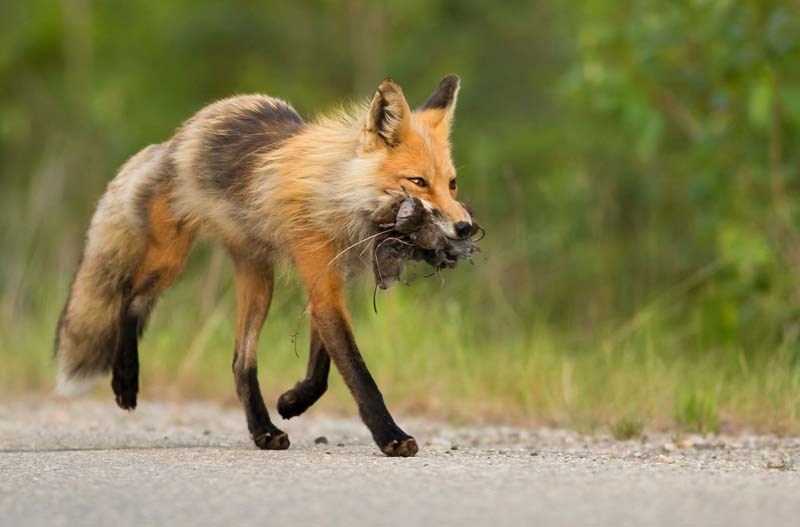There are two kinds of calls that will make me drop everything and run out of the office. The first is a fire. The second is a fox.
The red fox is a relatively uncommon sight in civilized parts of St. Albert, so I'm always willing to dash out for a look when one's reported. I've seen a pair of curious kits frolicking in the underbrush along Green Grove Drive, for example, and a panicked yearling scurrying about its cage as a trapper hauled it out of town.
City community sustainability manager Leah Kongsrude says she got a lot of reports about a three-legged fox in town last year.
"He looked perfectly healthy," she says, and had a habit of walking on the sidewalk.
"It was quite funny."
With its bright red fur and bushy, white-tipped tail, the red fox is tough to miss when it shows up.
That tail is an easy way to tell if you've got a fox or a coyote, says Dick Dekker, a wildlife ecologist in Edmonton who's spent much of his 80 years studying these predators. A red fox's tail flies straight behind it while in motion, he notes, occasionally going straight up when it's on the hunt. Coyotes let their tails hang low.
Red foxes often have black paws and ears, as well as white stockings and bellies. "Cross" foxes have a black cross on their back, while "silver" ones are black with white-tipped hairs. Silver foxes were worth a fortune back in the day, Dekker says.
"There is no more graceful creature in nature than the red fox," he continues.
Foxes weigh less than eight pounds. As their tail floats on the wind, their feet can dance on the snow, barely leaving a dent with their catlike treads.
They are also very playful, as is evident when the young ones wrestle with each other around the den in June.
"Few scenes in nature are as charming as watching a fox family at play," Dekker says.
Red foxes prefer marshy areas and farms (such as Big Lake), but will venture into heavily forested residential areas, says Lu Carbyn, a wildlife biologist at the University of Alberta who studies wild dogs. Most foxes will be in loose family groups of two to three around this time, and will become solitary hunters come winter.
The fox is a shy but clever creature and is the subject of many myths extolling its intelligence.
"The fox is smart enough to live right under the nose of its enemy," Dekker says.
He's seen many cases of red foxes living under homes surrounded by big dogs, using the dogs to scare off predatory coyotes.
Carbyn recalls watching a fox in Wood Buffalo National Park one winter as it fed on a rock-hard bison carcass.
"At minus 30 Celsius, as you can imagine, the meat is frozen solid," he says, but this fox was smart enough to chomp down and use its mouth to thaw the meat until it was soft enough to eat.
Most people have seen videos of foxes on the hunt, Dekker says.
"The fox has a fantastic nose," he says, and can smell and hear mice and voles scurrying under two feet of snow.
Once it zeros in on its target, the fox will stand very still, take a few steps for positioning, then leap straight up into the air, coming down on its front paws for maximum impact to crush the creature in its underground tunnel. The fox digs into the snow, "and you see the fox come up with the vole in its mouth, triumphant."
Not a threat
Kongsrude says she gets about two to three red fox calls a year, often from residents concerned about their pets. The foxes are almost never a threat, she notes, and are simply curious.
"They just want to chat."
While foxes can quickly acclimatize to human contact, Carbyn says they're much less dangerous to your pets than a coyote. If you're really worried, you can always call a provincial wildlife officer.
If you see a red fox, Dekker recommends that you appreciate it from a distance, as he did one time when he saw one hunting in the winter sun on a bleak, snow-covered plain.
"The way he raises his head when he comes up with the vole in his beak is priceless."
Red fox
Name:
Vulpes vulpes.
Appearance:
Small, dog-like mammal with sharp, pointed face and ears, lustrous fur and long bushy tail; usually red with a white tip on the tail, but can be black or brown.
Commonly seen:
Pouncing on mice in the snow, or frolicking in the bush near Big Lake or Grandin.
Occasionally confused with:
Coyotes, which are bigger and sandy coloured, or dogs.
Fun fact:
They can produce 28 different vocalizations.
Wild St. Albert
Like wildlife? So do we! Every second Wednesday the Gazette profiles a reasonably common wild creature in the St. Albert region. Birds, beasts, bugs, fish … so long as it's alive and kicking, we'll feature it. <br /><br />Got a creature you'd like to see profiled? Send your suggestions to [email protected].




